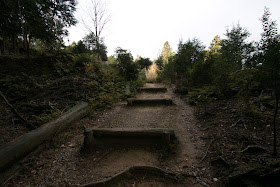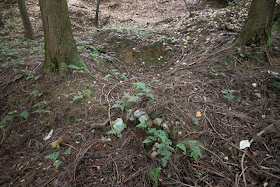Matsuoyama Castle
-Castle of miscalculations at important border-
Overview
Name: Matsuoyama castle (Matsuoyama-jo)
Alias:
Place: Yamanaka Sekigahara town, Gifu
Type: Mountain Castle
Built: 16th century
Remaining remnants: Gates, stone walls and moats
Title:
Brief History
Matsuoyama Castle (松尾山城) is built at the top of Matsuo-yama mountain, one of about 200 meter tall from hillside at the south of narrow path of Sekigahara area. Sekigahara area is the place where Nakasendo-Road, a major old road connected Kyoto city and Kanto region crossed the border of Omi province (Shiga prefecture) and Mino province (Gifu prefecture), and Matsuoyama castle was an appropriate place to control Nakasendo road which passed at the north of mountain, and a by-pass road run at south side at the same time.
Importance of Sekigahara area
Sekigahara area is a narrow path sandwiched by Ibuki mountains and Suzuka mountains, which separated Honshu main land into western half and eastern half. Even now, accents, dialects and cultures shows clear difference at the both side of Sekigahara. Other than Sekigahara there are several passes such as Suguka-Toge pass or Kabuto pass to cross this line, but they were tough mountain road and detour ways. Thus historically Sekigahara area had been the most important area to connect Eastern and Japan, and even now most important traffic lines pass this area.
Because of this geographical reason, Sekigahara area experienced several large battles between the eastern power which tried to intrude into Kinki region with large army and western power tried to protect at this point. In 672, at the battle of Jinsin between Prince Oama (631-686, later Emperor Tenmu) and his nephew Prince Otomo (649-672), Prince Oama broke Prince Otomo army at Sekigahara area and intruded into Omi province.
Furthermore, in 14th century, Akiie Kitabatake (1318-1338) who was the general of South Court and made long expedition from Tohoku region toward Kyoto city made fierce battle against North Court army around this area. At this time Akiie broke North Court army but did not have capacity to attack Kyoto city directly, thus turned to Ise province (Mie prefecture). Finally, in 1600, Sekigahara area became the field of the battle of Sekigahara, a decisive battle between Ieyasu Tokugawa (1543-1616) and Mitsunari Ishida (1560-1600).
Origin of Matsuoyama castle
It is said that Matsuoyama castle was built by Tomishima clan, a deputy governor of Mino province as a border castle toward Omi province in 15th century. In the former half of 16th century, Toki clan which was the governor of Mino province and Kyogoku clan served as the governor of north half of Omi province lost power and were took over by Saito clan and Azai clan respectively, but Matsuoyama castle did not change its role.
In 1568, Nobunaga Oda (1534-1582), the warlord of Owari province (western half of Aichi prefecture) who captured Mino province two years ago, allied with Nagamasa Azai (1545-1573), the lord of Azai clan, then marched toward Kyoto city. Nobunaga with overwhelming army expelled Rokkaku clan or Miyoshi clan which reigned Kinki region and built his own government.
But in 1570, when Nobunaga attacked Asakura clan which was the strong warlord of Echizen province (Fukui prefecture), Nagamasa Azai suddenly left Nobunaga and turned to Asakura clan, as Azai clan owed to Asakura clan which supported the independence of Azai clan from Rokkaku clan in the past. Asakura and Azai army tried to shut the communication between the army of Nobunaga at Kinki region and their main base Owari province and Mino province at the point of Sekigahara.
Miscalculation of Azai clan
At this time Azai clan ordered their retainer Hori clan which was the lord of Kamaha castle (Shiga prefecture) to reform Jyoheiji castle and Takekurabe castle at Omi side of Sekigahara area. Furthermore, Hori clan proceeded into Mino province and significantly expanded Matsuoyama castle, to completely shut Sekigahara area. Because of this blockage, Nobunaga had to detour Sekigahara area and pass Happu Toge pass or Chigusa Kaido road for a while.
But when Asakura army returned to Echizen province, because of the plot of Hideyoshi Hashiba (1537-1598, later Hideyoshi Toyotomi) who was still a middle class general of Nobunaga, Hori clan turned to Nobunaga then Oda army recovered the communication through Sekigahara area.
Soon Nobunaga gathered his all army then broke Asakura and Azai army at the battle of Anegawa, then reversely encircled Azai clan at its main base Odani castle. For Azai clan. betrayal of Hori clan and loss of Matsuoyama castle might be a serious miscalculation.
After three year struggle, Nobunaga finally ruined Nagamasa Azai at Odani castle in 1573. Hideyoshi became the lord of former Azai territory, and next year Hori clan which lost utility value was expelled by Nobunaga. Mitsuharu Fuwa (?-?) stayed as a commander of Matsuoyama castle for a while, but there became no need to protect the border any more then Matsuoyama castle was once abolished around 1576.
Transition of time and second usage
It was supposed that Matsuoyama castle disappear in the history, but about 25 years after, Matsuoyama castle emerged into the stage of history again. Nobunaga Oda seized most part of central Japan and at the corner to unification but died in the incident of Honnoji, a coup d'etat by his general Mitsuhide Akechi (1521-1582) in 1582.
Hearing the death of Nobunaga, Hideyoshi Hashiba who was the regional commander of Chugoku region quickly returned his army to Kinki region and broke Mitsuhide at the battle of Yamazaki, then became the successor of Nobunaga and united Japan in 1590.
But after the death of Hideyoshi in 1598, Ieyasu Tokugawa who was the largest lord under Toyotomi government and Mitsunari Ishida, the chief magistrate of Hideyoshi, fought for next hegemony. In 1600, during the expedition of Ieyasu toward Uesugi clan of Aizu area at far east, Mitsunari raised his army with other large lords such as Mouri clan or Ukita clan then seized most part of Kinki region.
As Ieyasu had larger and stronger army than Ieyasu, Mitsunari might have planned to protect the border of Mino province and Omi province firmly and gain time, then seize the territory of enemy side lords at Kinki region, Chugoku and Shikoku region and cooperate with Uesugi army who might seize whole Tohoku region.
Mitsunari also held economic resource of Kyoto and Osaka city, and held two political legitimacy Hideyori Toyotomi (1593-1615), son of Hideyoshi and Emperor Goyozei (1571-1617) at his area, even though both expressed neutrality. On the other hand, Ieyasu had stronger army but had to break Mitsunari as quickly as possible to avoid long time battle. Based on this strategy, Mitsunari thought Gifu castle and Ogaki castle as front forts, and reformed Matsuoyama castle as a main base of their nominal leader Mouri clan.
Structure of Matsuoyama castle
Matsuoyama castle is built utilizing ridges and valleys of Matsuo-yama mountain. Central area of the castle is a rectangular area of about 40 meter long and 20 meter wide, surrounded by clear clay wall. As a place of general commander this place has a good scenery of Sekigahara area, and had a Masugata style gate with folded path at backside. At the south of central area, there is a narrow area of about 50 meter long held clay wall at both side, which might work as a buffer area toward central area.
Ahead of small valley at the west of central area, another large terrace of 50 meter long and 20 meter wide which is well formed and also guarded by clay wall is built. A line of clay wall and corridor runs at the north slope of the mountain from this western area to the below of central area and another front fort at northeast, which was added at this time assuming the usage of matchlock guns.
Around these core areas, many terraces built utilizing slopes between ridges. These terraces might be planned to use as a camping or storage space, which shows this place was reformed as a headquarter. At the south of western terrace there is another area faces southward, but this area is backside from Sekigahara then might not be reformed at this time. Total size of the castle is about 400 meter long and 300 meter wide, and matching as a headquarter of Mouri clan.
Miscalculation of Mitsunari
But the plan of Mitsunari did not work as thought. Although Masayuki Sanada (1547-1611), the lord of Ueda castle (Nagano prefecture), obstructed second army of Tokugawa clan lead by Hidetada Tokugawa (1579-1632), Gifu castle which was thought as a front fort against Tokugawa army fell only in one day. Mitsunari sent certain part of his army to seize different places of Kinki region, but these troops faced struggle of the enemy and consumed time.
To avoid the intrusion of Tokugawa army into Omi province, Mitsunari had to withdraw the front line to Sekigahara. But Terumoto Mouri (1553-1625), the leader of Mouri clan and the planned general commander who was to enter Matsuoyama castle, did not move from Osaka castle because of the plot of Ieyasu. Furthermore, Matsuoyama castle was occupied by Hideaki Kobayakawa (1577-1602), a distant relative in law of Hideyoshi and nominally belonged to Mitsunari but already connected to Ieyasu.
On September 15 of 1600, decisive battle of Sekigahara started. At first Ishida side army well fought against Tokugawa army, but Mouri army which resided at the Nangu-san mountain backside of Ieyasu did not move due to absence of their leader Terumoto Mouri.
Result of battle and afterward
Hideaki Kobayakawa with 15,000 soldiers also looked the transition of battlefield from Matsuoyama castle. Both side asked Hideaki to attack the enemy, but at the noon, Hideaki finally decided to change to Ieyasu and left Matsuoyama castle. Hideaki attacked the army of Yoshitsugu Otani (1565-1600), the commander of Tsuruga castle (Fukui prefecture) and sworn friend of Mitsunari, from side.
Yoshitsugu expected the betrayal of Hideaki once rejected this attack once, but faces further betrayal of small lords attached to Yoshitsugu, finally was outnumbered and died at battlefield. With this as a trigger, Ishida army collapsed and Ieyasu won this decisive battle. The strategy of Mitsunari was totally broken by political plots of crafty, and Matsuoyama castle became the symbol of miscalculation again.
Matsuoyama castle was prepared as a temporal base, after the battle the castle was not used any more. Today no building was left but structure of the castle well remain on the mountain. As Hideaki died in ill only two years after the battle, even thought an important event which decided the history of Japan, the reason of the betrayal of Hideaki is still unknown. Well built ruin of Matsuoyama castle shows careful preparation of Mitsunari and miscalculation exceed that, even today annoying us.
Access
30 minutes walk from JR Central Tokaido Honsen line Sekigahara station to hillside entrance. 15 minutes drive from Meishin Expressway Sekigahara interchange to hillside parking. 30 minutes walk from hillside to hilltop castle.
Related Castles
Kamaha Castle -Turret and stone wall watched border from mountain-























































































































































































































No comments:
Post a Comment